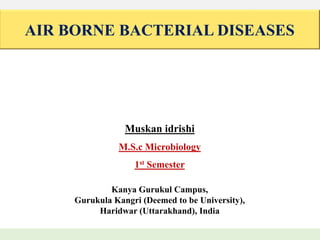
air borne bacterial disease.pptx
- 1. AIR BORNE BACTERIAL DISEASES Muskan idrishi M.S.c Microbiology 1st Semester Kanya Gurukul Campus, Gurukula Kangri (Deemed to be University), Haridwar (Uttarakhand), India
- 2. Contents INTRODUCTION TRANSMISSION OF AIR BORNE BACTERIAL DISEASES HAZARDS OF BACTERIAL AIR BORNE DISEASES TYPES AND EFFECTS OF BACTERIAL AIR BORNE DISEASES ON HUMAN TUBERCULOSIS PNEMONIA DIPHTHERIA PREVENTION TYPES AND EFFECTS OF BACTERIAL AIR BORNE DISEASES ON PLANTS FIRE BLIGHT CITRUS CANKER PREVENTION AND CONTROL REFERENCES
- 3. INTRODUCTION Airborne diseases are caused by pathogenic microbes that can be transmitted through the air. The relevant pathogen may be viruses, bacterial, fungi. These can be transmitted through breathing, talking, coughing, sneezing, laughing, raising of dust, spraying of liquids, toilet flushing and close personal contact or aerosolization of the microbe. The discharged microbes remain suspended in the air on dust particles, and water droplets. SPUTUM TRANSMISSION HAZARDOUS AIR BORNE BACTERIA
- 4. TRANSMISSION OF AIRBORNE BACTERIAL DISEAESE HANDSHAKE CONTAMINATED EGG SNEEZING COUGHING TALKING RAISING OF DUST CLOSE PERSON CONTECT LAUGHING
- 5. DIARRHEA FATIGUE COUGHING SWEATING FEVER CHEST PAIN WEIGHT LOSS BLOOD COUGH HAZARDS OF BACTERIALAIR BORNE DISEASES
- 6. TYPES AND EFFECTS OF BACTERIALAIR BORNE DISEASES IN HUMAN Bacterial airborne disease are:-Tuberculosis, pneumonia, diphtheria, whooping, etc. Bacterial airborne disease effects:- Allergens causes inflammation in the nose, throat and the lungs. DROPLETS FROM CAUGHING BY INFECTED PERSON DROPLETS TRANSMISSION FROM INFECTED PERSON AIR BORNE BACTERIA
- 7. Tuberculosis is commonly called TB. It is a contagious bacterial disease. It is cause by mycobacterium. Transmission spread from person to person through air. The bacterial can attack any part of the body, but it most commonly stick to the lungs and causes TB of lungs. Treatment by antibiotic (isoniazid and rifampicin). TUBERCULOSIS DROPLETS FROM SNEEZE BY AN INFECTED PERSON TUBERCULOSIS BACTERIA
- 9. Pneumonia Lower respiratory tract infection. Cause by streptococcus pneumonia. A serious illness of the lungs which makes breathing difficult. Transmission through airborne respiratory droplets (sneezes). Treated by antibiotics (azithromycin or erythromycin) along with rest and drinking plenty of water. STREPTOCOCCUS PNEUMONIA LOWER RESPIRATORY TRACT INFECTION
- 11. Diphtheria is an infections disease of the upper respiratory tract Disease cause by corynebacterium diphtheria. It is an gram positive bacillus. Transmission through airborne respiratory droplets (sneezing) and saliva. The membrane can obstruct breathing. Treated by antibiotics (penicillin or erythromycin) DIPHTHERIA OBSTRUCT THE AIRWAY CORYNEBACTERIUM DIPHTHERIA SWALLOWING OF LYMPH NODES
- 12. SYNPTOMS OF DIPHTHERIA SNEEZING SLEEPING SICKNESS CHILLS FEVER BREATHING DIFFICULTY SWALLOWING OF LYMPH NODES CAUGHING OBSTRUCT THE AIRWAY
- 13. PREVENTION Maintain good personal hygiene. Wear a mask properly Keep the environment clean and hygienic. Wash your hand after sneezing. Adopt a healthy lifestyle. Stay away from sick people. Ensure good ventilation.
- 14. TYPES AND EFFECTS OF BACTERIALAIR BORNE DISEASES ON PLANTS Bacterial disease can be damage to plant tissue and the symptoms that they cause, which may include vascular wilt, necrosis, soft rot, and tumors. Bacterial diseases are influenced greatly by temperature and moisture. Airborne bacterial diseases such as fire blight, soft rot, crown gall, citrus canker. CITRUS CANKER WATER-SOAKED ON LEAFS SPOTS ON STEMS
- 15. FIRE BLIGHT The oozing bacterial are carried by insects, wind, and rain to infect new plants and tissues. It is an contagious disease affecting apples, pears. Cause by Erminia amyluria. The spread intercellularly and upto 1.2 meters (4feet) through vascular tissue in the wood, during late spring and early summer, darkening, and killing the tissue. INFECTED PEARS BROWN SPOTS ON STEMS
- 16. SYMTOMS Apple plant affected by fire blight Pear plant affected by fire blight Brown spots on stem Blossoms appear water-soaked on leafs
- 17. CITRUS CANKER It mainly affects on citrus plants. It cause lesions on leaves, stems, and fruits of plants. There is no cure for citrus canker. Prevention is the best option to protect against citrus canker. Citrus canker high contagious and can be spread rapidly by:- Wind-driven rain Infected took and equipment's. Exposed plants. FRUIT RIND BLEMISHING DISEASE WATER-SOAKED ON LEAFS
- 18. SYMTOMS Water-soaked appearance. Fruit rind blemishing disease. Brown spots appearance on stem also.
- 19. PREVENTION Infected wood should be removed in late summer or winner when the bacteria are not actively spreading. Using canker disease-free nursery plants. Pruning and burning infected twigs. Spraying copped-based bactericides. Developing canker resistant varieties.
- 20. REFERENCES • https://www.healthline.com/health/airborne-diseases • https://www.sciencedirect.com/topics/immunology-and-microbiology/airborne- bacterium • A Text Book Of Microbiology By Dubey R.C. And Maheshwari
Notas del editor
- In the introduction section We all know about the.. We also know that According to a report .